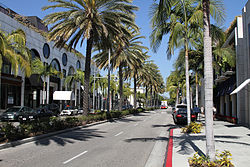Rodeo Drive

Rodeo Drive in 2012
|
|
| Location |
Beverly Hills, California Los Angeles, California |
|---|---|
| Coordinates | 34°4′9.23″N 118°24′10.76″W / 34.0692306°N 118.4029889°WCoordinates: 34°4′9.23″N 118°24′10.76″W / 34.0692306°N 118.4029889°W |
| South end | Beverwil Drive |
| Major junctions |
|
| North end | Sunset Boulevard |
| East | North Beverly Drive |
| West | North Camden Drive |
Rodeo Drive /roʊˈdeɪ.oʊ/ is a two-mile-long street, primarily in Beverly Hills, California, with its southern segment in the City of Los Angeles. Its southern terminus is at Beverwil Drive, and its northern terminus is at its intersection with Sunset Boulevard in Beverly Hills. The name is most commonly used metonymically to refer to the three-block stretch of the street north of Wilshire Boulevard and south of Little Santa Monica Boulevard, which is known for its luxury goods stores. The larger business district surrounding Rodeo, known as the "Golden Triangle," which extends from Wilshire Boulevard to Santa Monica Boulevard, is both a shopping district and a tourist attraction.
In 1906, Burton E. Green (1868-1965) and other investors purchased the property that would become Beverly Hills, formerly named Rancho Rodeo de las Aguas, with plans for a mixed-use subdivision with a branch of the Los Angeles and Pacific Railway running North on Rodeo Drive before turning west at Sunset Boulevard. They platted the street that very year, in 1906. By 1907, 75x160 foot parcels on Rodeo were selling for $1,100 each. It became a bridle path in 1912, when the Beverly Hills Hotel was built on a former lima bean field. By November 1925, similar lots were selling for between $15,000 and $30,000, almost double what they'd been selling for in September.
...
Wikipedia
